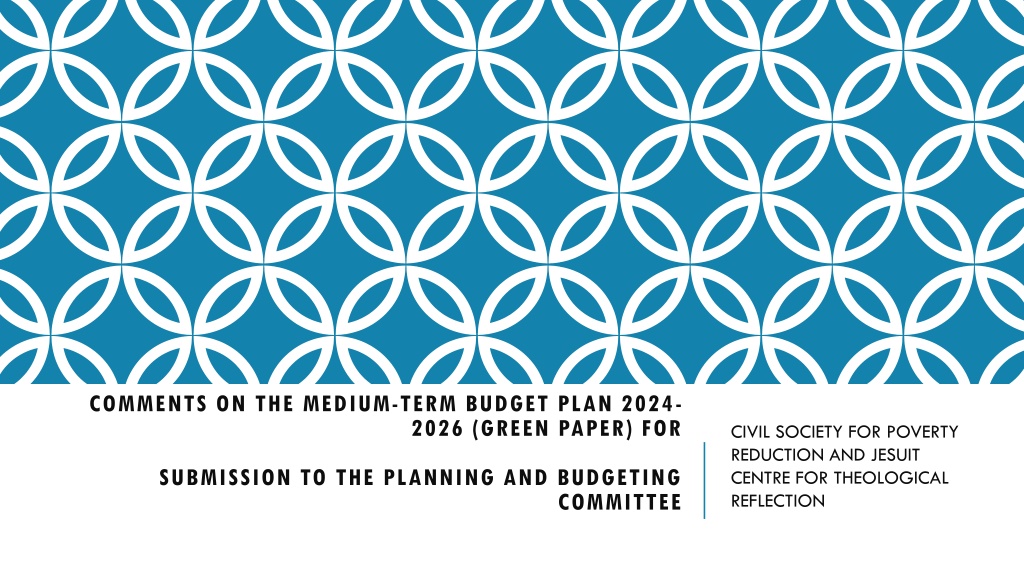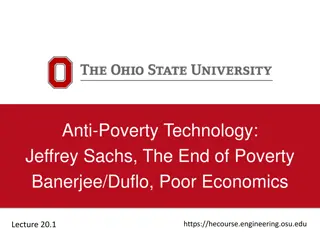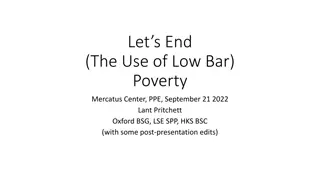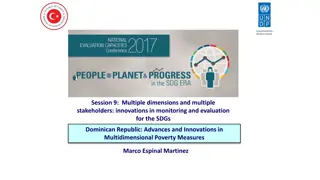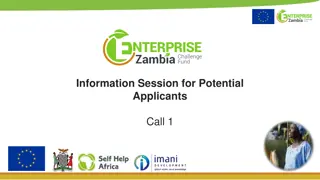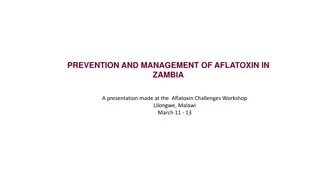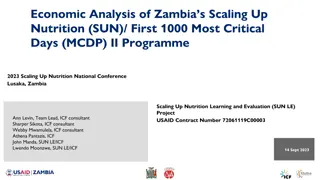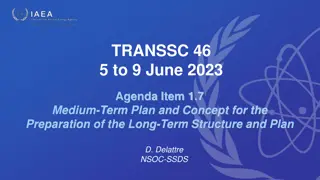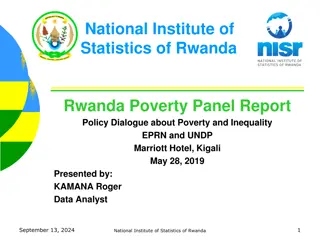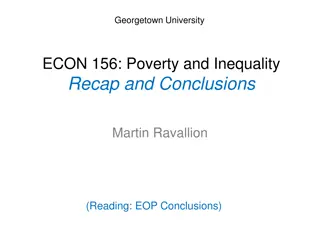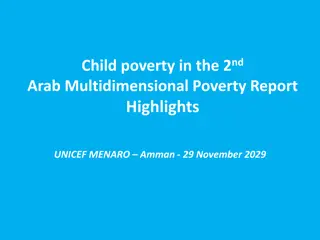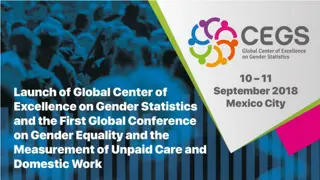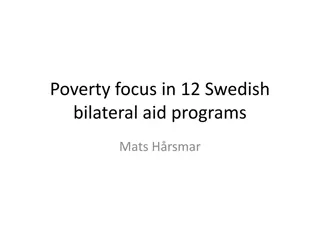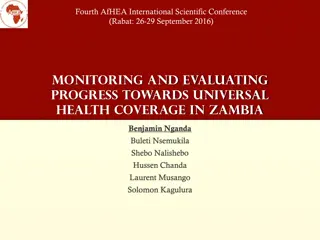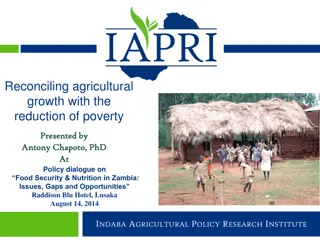Analysis of Zambia's Medium-Term Budget Plan 2024-2026 for Poverty Reduction
Zambia's economy faces challenges due to factors like debt restructuring delays and reduced output in key sectors. The cost of living remains high, impacting citizens' well-being. Effective strategies and combating corruption are crucial for achieving Vision 2030 goals amid economic instability. Government interventions must focus on restoring growth and managing debt levels to address current economic concerns.
Download Presentation

Please find below an Image/Link to download the presentation.
The content on the website is provided AS IS for your information and personal use only. It may not be sold, licensed, or shared on other websites without obtaining consent from the author. Download presentation by click this link. If you encounter any issues during the download, it is possible that the publisher has removed the file from their server.
E N D
Presentation Transcript
COMMENTS ON THE MEDIUM-TERM BUDGET PLAN 2024- 2026 (GREEN PAPER) FOR CIVIL SOCIETY FOR POVERTY REDUCTION AND JESUIT CENTRE FOR THEOLOGICAL REFLECTION SUBMISSION TO THE PLANNING AND BUDGETING COMMITTEE
INTRODUCTION This window of consultation on this critical document sits within the interest of CSPR and JCTR in view of our mandate. The two organizations have over the years been working together to monitor the macroeconomic fundamentals, their effects on public service delivery and poverty while advocating for appropriate policy and practice to improve the wellbeing of citizens within the context of a good governance environment. The Zambian economy has been undergoing a lot of challenges due to various factors ranging from both external and internal domestic forces. Various factors have contributed to the low economic performance such as the delayed debt restructuring process with Zambia s creditors. Zambia s debt contraction has not materialized into economic growth and growing debt servicing costs have weakened the economy and in turn stifled tax revenue collection.
DEVELOPMENTS IN THE DOMESTIC ECONOMY Zambia s economy is projected to slow down to 2.7% in 2023 from 4.7% recorded in 2022. This has mainly been attributed to the expected reduction in output in the mining and electricity sectors which are expected to contract by 8.7% and 2% respectively. Zambia s debt restructuring program with creditors was approved in July 2023 after a prolonged delay, which impacted various economic fundamentals such as the exchange rate. This is in addition to the IMF Program s Extended Credit Facility for economic and financial resurgence, which came with certain conditionalities such as the removal of fuel and agricultural subsidies. The economic environment has been fairly stable, with the annual inflation rate in Zambia eased marginally to 9.8% in June 2023, down from 9.9% in the prior month. This is attributed to price movements of selected food items. The inflation rate recorded in June 2023 is a slight increase from the 9.7% which was recorded in the same period in 2022. The same period in 2021 however recorded a high inflation rate of 24.6%. Annual Food Inflation for June 2023 was recorded at 11.2% compared to 11.6% recorded in the previous month. The reduction in food inflation was attributed to price movements in cereals (maize, samp, cassava meal), meat and vegetables.
DEVELOPMENTS IN THE DOMESTIC ECONOMY CONT D Our analysis presents a notable challenge as the cost of living so far remains out of reach for many and continues to worsen living conditions. Reviewing the BNNB trends, JCTR and CSPR observe that the cost of living continues to remain high and unattainable for the vast majority. As of June 2023, The cost of living for a family of five, as measured by the Jesuit Centre for Theological Reflection (JCTR) Basic Needs and Nutrition Basket (BNNB) in Lusaka, stood at K9, 239.45. Zambia s Vision 2030 to become a middle-income country by 2030 can only be achieved if the Government puts in various domestic mobilization strategies while at the same time combating corruption. Especially that we are now less than eight (8) years away from the year 2030. Further, the Government's national development plan should be anchored on restoring economic stability and growth, which has been undermined by the current high debt levels exacerbated by the COVID-19 pandemic.
ECONOMIC TRANSFORMATION AND JOB CREATION In the 2024-2026 medium term Budget Plan (MTBP), the Government has committed to revive growth by sustaining macroeconomic stability and ensuring the right policies and regulatory environment are in place to support private sector investment. This is in a bid to transform the Zambian economy from one which is currently predominantly dependent on the primary production of raw material in all key sectors such as mining and agriculture to an industrialized and diversified economy through value addition in the key sectors of agriculture, manufacturing, tourism and mining. Industrialization is a key driver of socio-economic transformation and job creation in both developed and developing countries. This concept can be understood as the development of the manufacturing sector or the transformation of an agrarian society into one driven using technology and machinery to enable mass production. The industrialization of a country s economy not only results in mass production of goods for both consumption and export but also presents an opportunity to improve the standard of living.
ECONOMIC TRANSFORMATION AND JOB CREATION Agriculture, Livestock and Fisheries sector The agriculture sector remains a backbone of the Zambia economy and cardinal in the growth and poverty reduction especially in rural areas where majority of the citizens depend on agriculture for livelihoods. Despite Zambia experiencing strong economic growth in the recent past, agriculture has not performed well as the sector has faced a number of constraints such as inconsistencies in policies that have not addressed the plight of rural farmers, insufficient national budgetary allocation to the agricultural sector, lack of access to markets by rural farmers, poor road infrastructure in many rural areas, inadequate delivery of extension service as well as lack of value addition capacities on the agricultural produces due to lack of fully developed agro-industries resulting in the selling of raw materials by the rural farmers. Additionally, Zambian rural farmers have continued monocropping, specifically growing maize which has expedited the poverty levels in rural areas. Government has Proposed measures and objectives (in MTBP) for the sector such as full implementation of the Comprehensive Agriculture Transformation Support Programme (CATSP) that addresses the entire agricultural production and productivity value chain.
ECONOMIC TRANSFORMATION AND JOB CREATION Recommendations In order to be able to harness agricultural potential and to transform rural communities, the government of Zambia must put in place policies aimed at transforming rural areas into mechanized agrarian societies. Agrarian change is the transitioning, improving or changing agricultural practices so that they become mechanized and run as a business to ensure rural farmers are generating income from agricultural activities. Most rural farmers use a traditional mode of production which does not provide sufficient production from the agricultural sector. In order to achieve this transformation, the government of Zambia needs to spark a new agricultural revolution where Zambians will own the means of production and will directly benefit from agriculture.
ECONOMIC TRANSFORMATION AND JOB CREATION Mining Sector The mining sector remains the bedrock of Zambia s economy as it contributes significantly to GDP and has been the fastest growing sector in the economy. Zambia s mining industry has been an essential and integral component of nation s economic development which can be traced back to pre-colonial days. Mining has been the fastest growing sector contributing significantly to Zambia s Gross Domestic Product (GDP). However, most of its minerals are extracted and exported in their raw state. The processing of its minerals into higher value output and products is done elsewhere. Hence, Zambia is not only earning the minimum amount from its resources through the export of unprocessed ores but also restricting opportunities to diversify its economy, thereby leaving Zambia vulnerable to the fluctuations of global resource markets. Government has Proposed measures and objectives (in MTBP) for the sector such as increased investments in the sector which are aimed at boosting copper production, ultimately working towards the goal of achieving the production of 3 million metric tonnes of copper per annum.
ECONOMIC TRANSFORMATION AND JOB CREATION Recommendations Mineral resources offer wide-ranging opportunities to build industries to supply inputs for the mining sector, to produce key mineral-based feedstocks for other sectors, and to manufacture intermediate and finished value-added products for domestic consumption that will promote local and regional economic development. Manufacturing Sector Manufacturing is critical in stimulating growth and achieving value addition. However, the contribution of the sector to GDP remains low to contributing to attaining real economic transformation. Sustainable job creation will require the increased production of value-added products and the exploitation of export markets in which Zambia has a competitive advantage. Increased investment in manufacturing will promote strong backward and forward linkages with other sectors such as agriculture and mining which are key catalysts for higher and sustainable economic growth and job creation. Government has Proposed measures and objectives (in MTBP) for the sector such as increased value addition in the agriculture, mining and forestry sectors.
ECONOMIC TRANSFORMATION AND JOB CREATION Recommendations To successfully diversify and industrialise, the Government will need to implement interventions aimed at accelerating growth in the manufacturing sector. Among them will be; Ensuring increased local content and investment for value-addition to products from the agriculture, forestry and mining sectors as well as trade facilitation. Focus within the manufacturing sector must be on light manufacturing which is characterised by operations that are less capital intensive but more labour intensive. Promote the development and operationalisation of multi-facility economic zones and industrial parks including through the provision of appropriate incentives.
ECONOMIC TRANSFORMATION AND JOB CREATION Energy Sector Energy is the backbone for development, serving humanity and driving economic growth. Zambia s main economic sectors such as mining, agriculture, tourism, and trading all depend on equitable and secure access to energy. However, investment in the sector has not grown in proportion to the demand for energy. Government has Proposed measures and objectives (in MTBP) for the sector such as increase the country s electricity generation capacity and establishing and operationalize a one stop shop that will facilitate the coordination of all institutions involved in the permitting and licensing process in the development of energy projects to enhance efficiency and attract investment. Recommendations Introduce price ceilings in the management of petroleum products. Enhance research and development in the energy sector. The pump price of fuel on the domestic market has been fluctuating every month due to the frequent price reviews. Government to consider possibility of a mechanism that will aid stabilise the price of fuel because instability in petrol prices affects various aspects of economic development.
ECONOMIC TRANSFORMATION AND JOB CREATION Tourism Sector Zambia s vast natural beauty, wildlife and attractions make the tourism sector one of the vital economic sectors that can significantly contribute to economic diversification and job creation. Zambia is blessed with many tourism hotspots including 20 national parks, 34 game management areas, four major rivers, 16 major waterfalls including the mighty Mosi-o-Tunya Falls, eight freshwater lakes, diverse wildlife and more than 780 bird species. However, tourism to Zambia falls far short of the sector s full potential, with fewer foreign visitors than comparable countries. Similarly, the average visitor stay in Zambia is also lower than our neighbours. As a result, the tourism sector s contribution to GDP is meagre at about three percent. Government has Proposed measures and objectives (in MTBP) for the sector such as development of the Northern and Southern Circuits particularly around Kasaba Bay and Liuwa National Park through the facilitation of requisite infrastructure and Improving the regulatory and licensing framework for the sector by reviewing legislation with the overall objective of reducing the cost of doing business to unlock and attract transformative investment in the sector.
ECONOMIC TRANSFORMATION AND JOB CREATION Recommendations Maintain a stable economic landscape to reduce the cost of doing business, including streamlining license acquisition, easing tax compliance, visa processing and exemptions, and improving connectivity. Put in place a robust tourism marketing strategy to incorporate all tourism products including traditional ceremonies, visual arts, culture, heritage sites and others. Transport Sector The transport sector plays an important role in economic growth. It facilitates commerce and trade in goods and services as well as the movement of people. Zambia is a landlocked country and depends on a strong and efficient transport system for the smooth transit of exports and imports and growth of its economy. However, economic conditions and poor maintenance of transport infrastructure mean that this industry faces significant challenges, and requires further investment. Government has Proposed measures and objectives (in MTBP) for the sector such as recapitalisation of the Zambia Railways and TAZARA networks which are aimed at contributing to the opening up of rural areas for development and enhancing the participation of local communities in the economy.
ECONOMIC TRANSFORMATION AND JOB CREATION Recommendations Government must prioritize maintenance, development, modernisation and integration of road, rail, air and water transport infrastructure. This will also contribute to the opening up of rural areas for development and enhancing participation of local communities in the economy. Expedite strengthening of local level capacities for planning and development of transport infrastructure. Government must take deliberate steps to ensure bulk cargo is moved off the roads to the railway line through improvements to rail infrastructure. Information and Communications Technology Sector Information and communication technology (ICT) is pivotal in socio-economic development and employment creation as it cuts across all sectors. ICTs are also vital for enhancing trade through provision of ecommerce platforms as well as deepening financial inclusion. Government has Proposed measures and objectives (in MTBP) for the sector such as Investment in the construction of ICT infrastructure and increased use of ICT services. The focus will be to integrate digital technologies into business processes which are key to enhancing efficiency and productivity for economic transformation.
ECONOMIC TRANSFORMATION AND JOB CREATION Recommendations Government must implement the National Digital Transformation Strategy and review the Information and Communication Technology Act No. 15 of 2009. This will create an enabling environment for uptake of digital services by enhancing opportunities for investment in infrastructure and use of digital platforms. Promotion of STEM in institutions of learning to build a critical mass of qualified human resource for research and development, by leveraging on digitalisation. Investment in building digital skills, especially among the youth to provide a sound foundation for innovation.
HUMAN DEVELOPMENT Education The introduction of the free education policy in the country serves to provide equitable and quality education for all. Other scores in the education sector include consistent provision of school grants as well as use of recovered assets to support higher education. This however comes with challenges of overcrowding in classrooms due to increased enrolments. Although the last Education statistics bulletin the Ministry of Education produced was for 2020, interactions with most public schools have revealed increased enrolments starting in 2021. Government has Proposed measures and objectives (in MTBP) for the sector such as Construction and rehabilitation of primary and secondary schools infrastructure, construction of teachers housing facilities, completion of university infrastructure and provision of teaching and learning materials and Continue with the teacher recruitments and promotions.
HUMAN DEVELOPMENT Recommendations The recruitment of teachers should prioritize specialized teachers for learners with special needs, early childhood education and adult literacy. This will address the challenge of high teacher to pupil ratio for these three categories Under school infrastructure, the government should increase spending towards the construction and rehabilitation of early childhood education centers, particularly in rural areas. Social Protection Sector Social protection programs continue to provide essential support to the poorest and vulnerable households in the country. Government has Proposed measures and objectives (in MTBP) for the sector such as Continue supporting the poor and vulnerable through the Social Cash Transfer Scheme and other social safety nets such as the Food Security Pack, Public Welfare Assistance Scheme, Keeping Girls in School and the Home-grown School Feeding Programmes.
HUMAN DEVELOPMENT Recommendations Guidelines for the cash plus; There is need for clear guidelines for implementation of the cash plus. The Ministry of community Development and social services must intensify sensitization of the cash plus at community level and set clearly the time periods during which beneficiaries can receive assistance Health Government has Proposed measures and objectives (in MTBP) for the sector such as Improving health and nutrition through increasing access to quality health care, recruiting health personnel, promoting the participation of non-state actors in health care delivery, strengthening integrated health systems and enhancing food security and nutrition. Recommendations Adequate resources allocation and expenditure for the procurement of drugs and medical supplies. Institutional systemic issues (procurement, storage)
ENVIRONMENTAL SUSTAINABILITY Government has Proposed measures and objectives (in MTBP) for the sector such as Government will strengthen climate change adaptation and mitigation by developing climate resilient infrastructure. Extend and improve coverage of early warning systems to facilitate preparedness and prompt response to adverse weather effects. Government will promote innovative financing and spearhead resource mobilisation for climate change interventions such as the use of green bonds and carbon trading. Recommendations Establish a National Climate Change Fund to enhance climate change initiatives and reduce reliance on funds from cooperating partners. Expediate the enactment of legislation to enhance implementation of programs and activities. This will also allow for government to set standards and capitalize on the benefits of carbon trading and green bonds. Government, in its fight against unsustainable charcoal production, should prioritize renewable energy projects that will result in increased energy access and less dependence on charcoal while increasing energy security and fostering job creation in the sector.
GOOD GOVERNANCE ENVIRONMENT Over the medium term, focus will be on improving the policy and governance environment as well as promoting adherence to the rule of law and constitutionalism. In this regard, adherence to transparency and accountability will be prioritized in the management of public resources. In this regard, the Government will strengthen the implementation of Public Finance Management (PFM) reforms to ensure budget credibility, improve the efficient use of public resources and support private sector led growth. Recommendations Enacting and implementing the Access to Information legislation: this will aid the duty bearers to proactively disclose public information. Also, it will aid the citizens and non-State actors to be interested in public information as well as holding duty bearers accountable in the utilization and management of public resources. Operationalizing ACC offices in districts: this will make the ACC more effective at the grassroots in districts. Furthermore, it will enhance the rate of concluding corruption cases, since some corruption cases will be concluded at the district level. Revising the policy and legal framework governing the implementation of CDF (CDF Act , Local Government Act and the CDF guidelines).
REVENUE MOBILIZATION AND FINANCING STRATEGY FOR 2024-2026 In the medium term, revenues are expected to grow from K111.6 billion in 2023 to K134.9 billion, K152.4 billion, and K172.9 billion and averaging K153.4 billion between 2024 to 2026. This is an increase of 15.5% when compared to the 2023-2025 average projection of K132.8 billion. Government has Proposed measures and objectives (in MTBP) such as Foster sustainable domestic resource mobilization and increase domestic revenue to atleast 22.2% of GDP by 2026, Strengthen tax policies, improve taxpayer compliance and strengthen tax administration capacities by setting up a conducive tax environment for the private sector and Operationalize the implementation of the electronic invoicing system (EIS) by January 2024 to assure greater integrity of the invoicing system, for VAT purposes in the country.
REVENUE MOBILIZATION AND FINANCING STRATEGY FOR 2024-2026 Recommendations Government should come up with measures to ensure that cases reported by the Auditor General s Office face disciplinary action. This should also include enhancing coordination between the Auditor General s Office and Law Enforcement Agencies. Enhance tax capacity and administration of the economy Enforce existing policies and laws to ensure adherence; public Procurement Act and Public Financial Management Act. Government should come up with measures to curb tax evasion and illicit financial flows, reinforced by the Zambia Revenue Authority and the Financial Intelligence Center. This should also include strategies to reform Double Taxation Agreements.
REVENUE MOBILIZATION AND FINANCING STRATEGY FOR 2024-2026 Medium term functional allocations The Medium-term budget plan has the following targets with regards to functional allocations of resources. Government has prioritized resource allocation to policies and strategies that are outlined in the National Development Plan, i.e., the 8NDP. Resources have been allocated to foster economic transformation by building economic resilience and protecting the vulnerable. This is commendable, considering that the 8th National Development Plan was launched in 2022 as a road map to achieving our aspirations to be a middle income country by 2030, as espoused in the Vision 2030. Over the medium term, the Economic Affairs Function will take up a larger share of total expenditure at 27.9%, followed by the General Public Services at 27.7%. This is different from the 2023-2025 MTBP where General Public Services had a projection of 43.8% allocation due to debt servicing obligations, thereby affecting fiscal space of the National Budget. The 2023-2025 MTBP however projected an allocation of 19.5% towards economic affairs in the medium term to finance investments in agriculture and infrastructure development.
REVENUE MOBILIZATION AND FINANCING STRATEGY FOR 2024-2026 Recommendations Ensure that borrowing is within limits, as a requirement under the Public Debt Management Act to borrow at only 65% of GDP. This will improve transparency in debt contraction while at the same time meeting development aspirations and effective implementation of the IMF Program and debt restructuring. In the 2024-2026 MTBP, the Government has projected debt service payments of K117.4 billion or 16.5% of GDP over the medium term. Of this, K38.9 billion will be spent in 2024, K34.8 billion in 2025, and K43.6 billion in 2026.
